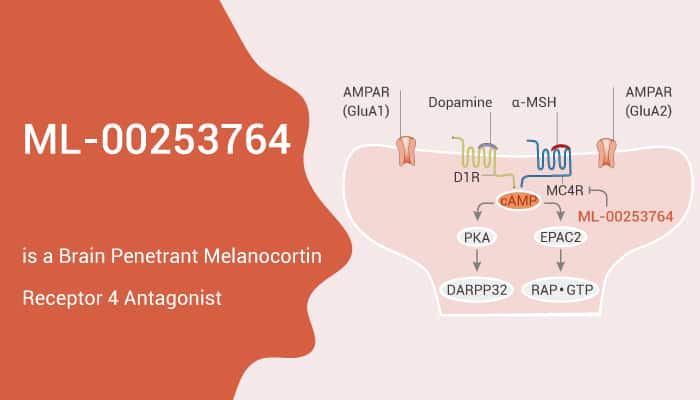The involuntary weight loss that occurs as some diseases poses a serious medical problem. For example, sarcopenia, cancer cachexia, rheumatoid arthritis, and hip fractures can lead to involuntary weight loss.
The melanocortin 4 receptor (MC4R) plays a key role in body weight regulation and energy homeostasis. The signaling of this receptor is a tightly regulated process. Besides, it involves activation by the proopiomelanocortin (POMC)-derived melanocyte-stimulating hormones (α, β, and γ-MSH) and inactivation by agouti-related protein (AgRP).
In this article, we will introduce a melanocortin receptor 4 (MC4R) antagonist, ML-00253764.

ML-00253764 is a brain penetrant MC4R antagonist with a Ki and IC50 of 0.16 µM and 0.103 µM, respectively. In vitro, ML-00253764 displaces NDP-α-MSH binding with a mean IC50 of 0.32 μM, 0.81 μM, and 2.12 μM for hMC4-R, hMC3-R, and hMC5-R, respectively. Additionally, in MC4R-expressing HEK293 cell membranes, ML-00253764 decreases cAMP production induced by [NLE4, D-Phe7]-α-melanocyte-stimulating hormone ([NDP]-α-MSH) by 20%. But it has no effect on cAMP levels in MC3R- or MC5R-expressing membranes.
ML-00253764 is a benzamidine compound, The benzamidines 4 and 5 are nearly undetectable in the brain after an i.v injection. However, ML-00253764 shows significantly enhanced brain exposure with a concomitant increase in MC4R antagonism. After an s.c. injection with a dose of 30 mg/kg, ML-00253764 achieves brain concentrations in excess of its functional MC4R IC50 for longer than 6 h.
In CT-26 tumor-bearing BALB/c mice, ML-00253764 shows protection against tumor-induced bodyweight loss upon chronic, peripheral dosing in CT-26 tumor-bearing BALB/c mice.
At previous reference, natural or synthetic MC4R antagonist peptides (e.g., AgRP and SHU911912) produce robust chronic effects on feeding and body weight in vivo.
In summary, ML-00253764 is a novel class of small molecule MC4R antagonist. It has optimized -potency, metabolic stability, and CNS penetration in vitro and in vivo. ML-00253764 can be used for cancer research.
Reference:
[1]. Vos TJ, et al. J Med Chem. 2004 Mar 25;47(7):1602-4.